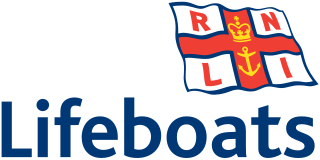
The Royal National Lifeboat Institution (RNLI) is the largest of the lifeboat services operating around the coasts of the United Kingdom, Ireland, the Channel Islands, and the Isle of Man, as well as on some inland waterways.
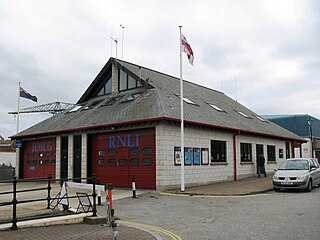
Falmouth Lifeboat Station is the base for Royal National Lifeboat Institution (RNLI) search and rescue operations at Falmouth, Cornwall in the United Kingdom. The first lifeboat was stationed in the town in 1867 and the present station was opened in 1993. It operates a Severn Class all-weather Lifeboat (ALB) and an Atlantic 85 inshore lifeboat (ILB).

Appledore Lifeboat Station is the base for Royal National Lifeboat Institution (RNLI) search and rescue operations at Appledore, Devon, England. The first lifeboat was stationed in the town in 1825 and the present station was opened in 2001. It operates a Tamar-class all-weather boat (ALB) and an Atlantic 85 B Class inshore lifeboat (ILB).

St Ives Lifeboat Station is the base for Royal National Lifeboat Institution (RNLI) search and rescue operations at St Ives, Cornwall in the United Kingdom. The first lifeboat was built for the town in 1840 and the present boathouse was opened in 1994. It operates a Shannon-class All-weather boat (AWB) and a D-class (IB1) inshore lifeboat (ILB).

Penlee Lifeboat Station is the base for Royal National Lifeboat Institution (RNLI) search and rescue operations for Mount's Bay in Cornwall, United Kingdom. The lifeboat station operated at various locations in Penzance from the early 19th century. It moved to Penlee Point near Mousehole in 1913, thus gaining its current name, but was moved to Newlyn in 1983 without any change of name. The station is remembered for the loss of the entire lifeboat crew on 19 December 1981.

Weymouth Lifeboat Station is the base for Royal National Lifeboat Institution (RNLI) search and rescue operations at Weymouth in Dorset, England. The first lifeboat was stationed in the town in 1869. It currently operates a Severn-class all-weather lifeboat (ALB) and an Atlantic 85 inshore lifeboat (ILB).
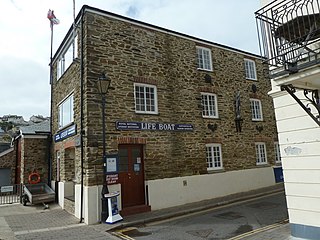
Salcombe Lifeboat Station is the base for Royal National Lifeboat Institution (RNLI) search and rescue operations at Salcombe, Devon in England. The first lifeboat was stationed in the town in 1869. The Salcombe Lifeboat has twice capsized, in 1916 with the loss of 13 lives, and in 1983 with no loss of life. Since 2008 the station has operated a Tamar-class all weather boat (ALB) and an Atlantic 85 inshore lifeboat (ILB).

Sennen Cove Lifeboat Station is the base for Royal National Lifeboat Institution (RNLI) search and rescue operations for the sea around Land's End, Cornwall in the United Kingdom. The first lifeboat was stationed at Sennen Cove in 1853. Since 2009 it has operated a Tamar-class all-weather boat (ALB) and a D-class (IB1) inshore lifeboat (ILB).

Exmouth Lifeboat Station is the base for Royal National Lifeboat Institution (RNLI) search and rescue operations at Exmouth, Devon, England. The first lifeboat was stationed in the town in 1803 and the present station was opened in 2009. In 2014 a new Shannon-class 25-knot all-weather boat (ALB) went on station. Also operated is a D-class (IB1) inshore lifeboat (ILB).

Torbay Lifeboat Station is the base for Royal National Lifeboat Institution (RNLI) search and rescue operations at Brixham, Devon in England. Brixham Lifeboat Station was opened in 1866 but since 1924 has been known as 'Torbay'. Since 2005 it has operated a Severn-class all-weather lifeboat (ALB) together with a D-class (IB1) inshore lifeboat (ILB).
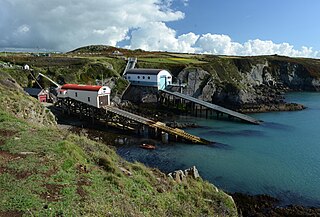
St Davids Lifeboat Station is a Royal National Lifeboat Institution (RNLI) station. It was opened in 1869 and to date has been involved in saving over 360 lives at sea in more than 420 launches. The station operates both an all-weather (ALB) and an inshore (ILB) lifeboat.

Eyemouth Lifeboat Station is located at the harbour town of Eyemouth, in the Scottish Borders, Scotland.

Clovelly Lifeboat Station, serving the North Devon village of Clovelly and surrounding coastal waters, is run by the Royal National Lifeboat Institution (RNLI). It was established in 1870. The station is flanked by Appledore to the northeast and Bude to the southwest.

Plymouth Lifeboat Station is the base for Royal National Lifeboat Institution (RNLI) search and rescue operations at Plymouth in England. The first lifeboat was stationed in the city in the early 1800s. The station moved to its present site at Millbay Docks in 1992, a Grade II-listed three-storey tower. Since 2003 it has operated a Severn-class all-weather boat (ALB) along with an B-class Atlantic inshore lifeboat (ILB).

Bude Lifeboat Station is the base for Royal National Lifeboat Institution (RNLI) search and rescue operations at Bude, Cornwall in the United Kingdom. It operates a D-class (IB1) lifeboats, which since 2012 has been the George Bird (D-756).

Thurso Lifeboat Station is located at Scrabster Harbour, in the NE corner of Scotland, near the town of Thurso, Highland, in the historic county of Caithness.
A lifeboat was first stationed here by the Royal National Lifeboat Institution in 1860.

Aith Lifeboat Station is located at the village of Aith, on the island of Shetland, and is the most northerly of the 238 Royal National Lifeboat Institution Lifeboat Stations. A lifeboat was first stationed here by the RNLI in 1933.
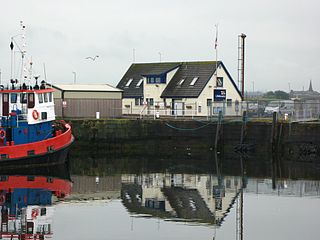
Troon Lifeboat Station is the base for Royal National Lifeboat Institution (RNLI) lifeboats at Troon in South Ayrshire, Scotland. It opened in 1871 and operates both all-weather and inshore lifeboats.

Campbeltown Lifeboat Station is the base for Royal National Lifeboat Institution (RNLI) lifeboat at Campbeltown in Argyll, Scotland. It opened in 1861 and today operates both inshore and all-weather lifeboats.

Rosslare Harbour Lifeboat Station is the base for a Royal National Lifeboat Institution (RNLI) lifeboat at Rosslare Harbour in County Wexford, Ireland.

























